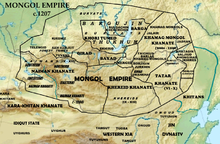Uriankhai

Mongol Empire c 1207, Uriankhai and their neighbours
|
|
| Regions with significant populations | |
|---|---|
|
|
26,654 (2010 census) |
| Languages | |
| Oirat, Mongolian | |
| Religion | |
| Tibetan Buddhism, Shamanism , Atheism | |
| Related ethnic groups | |
| Oirats, Mongols | |
Uriankhai (also written as "Uriyangkhai", "Urianhai", or "Uryangkhai") is a Mongolian term applied to several neighboring "forest" ethnic groups such as the Altai Uriankhai, Tuvans and Yakuts. The Uriankhai have been mentioned in medieval Chinese sources since the 10th century and the name appears several times in The Secret History of the Mongols. It is recorded in Chinese as Wulianghai (simplified Chinese: 乌梁海; traditional Chinese: 烏梁海; pinyin: Wūliánghǎi) or Wuliangha (Chinese: 兀良哈; pinyin: Wùliánghā).
The name "Uriankhai' means "uria" (motto, war motto) and khan (lord) in Mongolian. The Mongols applied the name to all the forest peoples and, later, to Tuvans. They were classified by the Mongols as Darligin Mongols.
At the beginning of the Mongol Empire (1206-1368), the Uriankhai were located in central Mongolia.
In 13th century Yuan China, Rashid-al-Din Hamadani described the Forest Uriyankhai as extremely isolated Siberian forest people living in birch bark tents and hunting on skis. Despite the similarity in name to the famous Uriyankhan clan of the Mongols, Rashid states that they had no connection. During the Ming dynasty, the Jurchens were known among the Chinese as "forest people" (using the Jurchen word, Woji), and this connotation later transferred to the Chinese rendering of Uriankhai, Wulianghai.
...
Wikipedia
